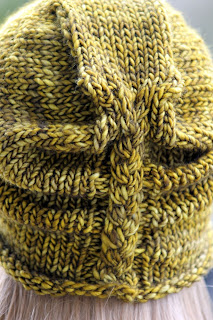 |
| I'm Lichen This Hat No, really. I'm really, really, REALLY lichen it. |
If recent years have taught me anything, it's that I am one of about six Americans who would rather eat rocks than watch a televised singing competition. Of course, I do have one odd exception to my music-free reality television preferences, the always-delightful The Sing-Off (I'm also lying when I say it's always delightful - 2014's weird Christmas special was no good. I miss Sara Bareilles). What's my point here? OH YEAH, PUNS! I think I like the show because of the constant and terrible puns that are constantly coming forth from host Nick Lachey's mouth. And, based on the name I came up with for this pattern, I also think the nice folks on TV's best a cappella singing competition program might tap me as a writer if the show ever gets another season.
Speaking of this hat, I got the design idea from a strange, ruched-looking entrance way I pass by every day on my way to my kids' schools, but you're just going to have to take my word for it because I've been too lazy to take a picture. I did get a lovely shot of some similarly-colored lichen, though, which made for a better pattern name anyway. You can find that below!
Yarn: Malabrigo Mecha (100% Merino Superwash Wool; 130 yards [120 meters]/100 grams); #031 Mostaza - one skein
 |
| A better view of the back, cute little braid and all! |
Notions: Tapestry needle, 4 stitch markers
Gauge: 12 stitches = 4 inches in stockinette on size US 11 needles
Which brings us to the pattern! Using your size 10 circular needle, then, cast on 66 stitches loosely, place marker, and join in round. Then we'll work a few edging rows, for which you'll need the following terminology. Remember you can always skip your cable needle, if you'd like.
back cross (bc): slip 2 stitches to cn and hold in back; k2, k2 from cn
front cross (fc): slip 2 stitches to cn and hold in front; k2, k2 from cn




